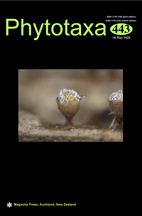Abstract
Zehneria monocarpa (Cucurbitaceae), a new species from the fragmented lowland coastal forests of Kenya is described here and illustrated with photographs. It resembles Z. oligosperma and Z. longiflora, but can be distinguished by its solitary female flowers and fruits. Furthermore, the new species has 1–23 conspicuous dark green glands on the apex of the leaf and the inner part of its receptacle tube is entirely hairy.

